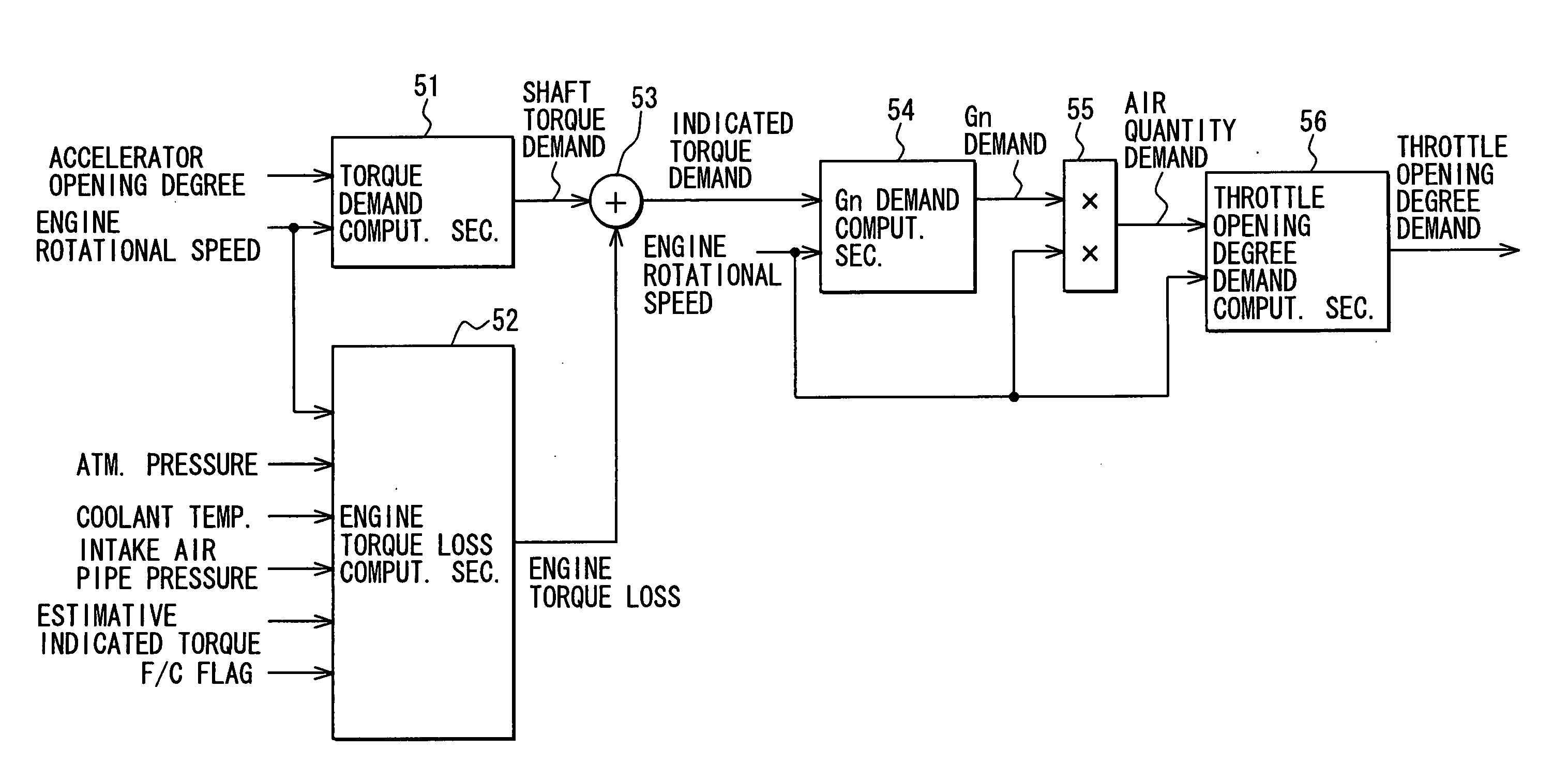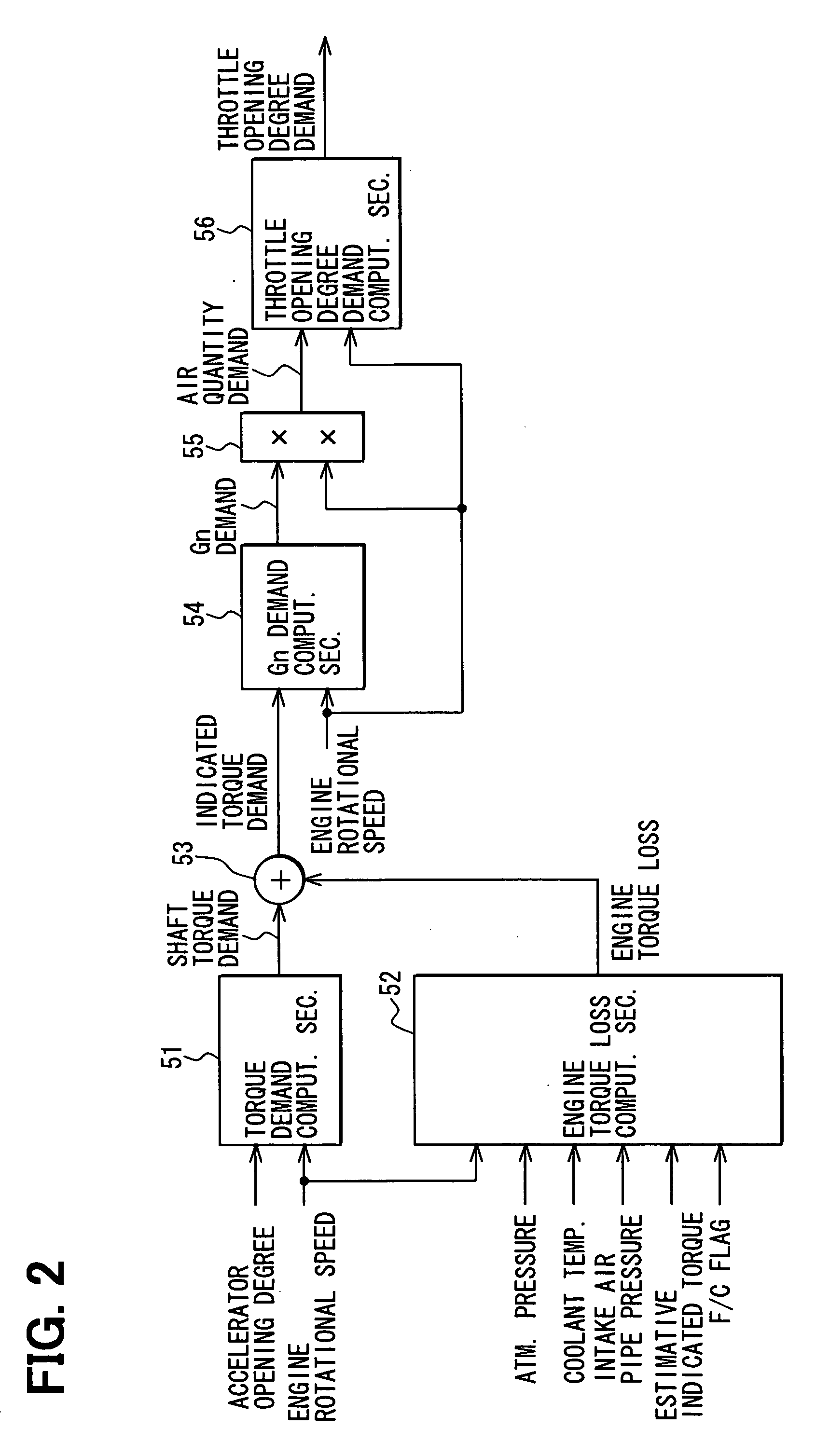Torque control apparatus and vehicle control system having the same
a technology of torque control and control apparatus, which is applied in the direction of electrical control, process and machine control, instruments, etc., can solve the problems of inability to achieve the torque demand, the inability to accurately compute the torque loss, and the change in the combustion state of the engine with time, so as to improve the torque control of the internal combustion engin
- Summary
- Abstract
- Description
- Claims
- Application Information
AI Technical Summary
Benefits of technology
Problems solved by technology
Method used
Image
Examples
first embodiment
[0033] A first embodiment of the present invention will be described with reference to the accompanying drawings. In the present embodiment, an electronic control unit (hereinafter, referred to as “ECU”) acts as a core unit of an engine control system (constituting a part of a vehicle control system) that controls an in-vehicle multi-cylinder gasoline engine (serving as an internal combustion engine), more specifically, for example, a fuel injection quantity and ignition timing of the engine. First, an entire structure of the engine control system will be described with reference to FIG. 1.
[0034] In the engine 10 of FIG. 1, an air cleaner 12 is provided in an upstream end of an intake air pipe 11. An airflow meter 13 is provided on a downstream side of the air cleaner 12 to measure an intake air quantity (a throttle passing air quantity). A throttle valve 14 is provided on a downstream side of the airflow meter 13. An opening degree of the throttle valve 14 is adjusted by a throttl...
second embodiment
[0065] Next, a second embodiment will be described while focusing on differences between the second embodiment and the first embodiment. In the present embodiment, there is implemented a control operation, in which the number of cylinders, i.e., the quantity of cylinders under the fuel cut (hereinafter, referred to as “F / C cylinder quantity” or alternatively “combustion stop mode cylinder quantity”) is variably set. That is, the engine is operated with the reduced number of cylinders, i.e., the reduced quantity of cylinders. Here, the correction of the engine torque loss is performed based on the F / C cylinder quantity. The F / C cylinder quantity may be computed according to a deviation between the estimative indicated torque and the indicated torque demand (=the estimative indicated torque−the indicated torque demand). Specifically, the F / C cylinder quantity is computed based on a quotient, which is obtained by dividing the torque deviation (=the estimative indicated torque−the indic...
third embodiment
[0072] Next, a third embodiment will be described while focusing on differences between the third embodiment and the first embodiment. In the present embodiment, the engine torque loss in the combustion period and the engine torque loss in the fuel cut-off period are individually computed, and one of these torque losses is selectively used to compute the current engine torque loss.
[0073]FIG. 12 is a block diagram showing an engine torque loss computing section 52 of the present embodiment. In the structure shown in FIG. 12, a first torque loss computing section 81 for computing the engine torque loss in the combustion period and a second torque loss computing section 82 for computing the engine torque loss in the fuel cut-off period are provided.
[0074] Here, the first torque loss computing section 81 and the second torque loss computing section 82 respectively use different characteristics to compute the pump torque loss and the frictional torque loss. FIG. 13A shows the pump loss...
PUM
 Login to View More
Login to View More Abstract
Description
Claims
Application Information
 Login to View More
Login to View More - R&D
- Intellectual Property
- Life Sciences
- Materials
- Tech Scout
- Unparalleled Data Quality
- Higher Quality Content
- 60% Fewer Hallucinations
Browse by: Latest US Patents, China's latest patents, Technical Efficacy Thesaurus, Application Domain, Technology Topic, Popular Technical Reports.
© 2025 PatSnap. All rights reserved.Legal|Privacy policy|Modern Slavery Act Transparency Statement|Sitemap|About US| Contact US: help@patsnap.com



